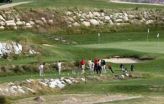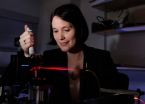New insights into cancer treatment
2011-03-16
Leuven - Jean-Christophe Marine (VIB, K.U.Leuven) strongly argues against the use of Cop1-inhibitory drugs. The protein Cop1 has –for a long time - been seen as an attractive drug target for cancer. But Jean-Christophe Marine found out that Cop1 acts as a tumor suppressor, and thus inhibits tumor formation. His new data will have direct implications for the development of cancer drug targets.
Tumorigenesis: loss of control
Tumors form when control over the cell division is lost; a process that could be compared to losing control over the speed of your car. Two main players ...
Surgical Mistakes More Common Than Patients Believe
2011-03-16
It is every patient's worst nightmare: to wake up in the recovery room after surgery to learn that something went wrong. In some cases, the bad outcome is simply a matter of chance: one of the known risks of the surgery happened to occur. But in other cases, the bad outcome is the direct result of the negligence of the physician performing the surgery and was entirely avoidable.
Surgical mistakes happen much more often than most Americans realize. Sometimes these mistakes are minor and may never cause any harm to the patients, but this is not always the case. According ...
Apnea may be cause for awakening and voiding for those with enlarged prostates report Ben-Gurion U.
2011-03-16
BEER-SHEVA, ISRAEL, March 15, 2011– Ben-Gurion University of the Negev (BGU) researchers have shown that a significant number of patients with benign prostate enlargement (BPE) may have Obstructive Sleep Apnea (OSA), which may be the reason for their night awakenings and urination.
This study compared men between the ages of 55 and 75 who were randomly sampled from primary care clinics, diagnosed with BPE and reported nocturia at least once nightly. The comparison control group had no BPE and one or no nocturia episodes per night.
According to the new study published ...
All wrapped up: K-State researcher's graphene cloak protects bacteria, leading to better images
2011-03-16
MANHATTAN, KAN. -- It's a cloak that surpasses all others: a microscopic carbon cloak made of graphene that could change the way bacteria and other cells are imaged.
Vikas Berry, assistant professor of chemical engineering at Kansas State University, and his research team are wrapping bacteria with graphene to address current challenges with imaging bacteria under electron microscopes. Berry's method creates a carbon cloak that protects the bacteria, allowing them to be imaged at their natural size and increasing the image's resolution.
Graphene is a form of carbon ...
EARTH: Still in a haze: Black carbon
2011-03-16
Alexandria, VA - Black carbon - fine particles of soot in the atmosphere produced from the burning of fossil fuels or biomass - a major contributor to the thick hazes of pollution hovering over cities around the world, has been known to be a health hazard for decades. But over the last decade, scientists have been examining in increasing detail the various ways in which these particles contribute to another hazard: heating up the planet.
Black carbon's impact on climate is not cut-and-dried, however, as EARTH explores in "Still in a Haze: What We Don't Know About Black ...
Brain injuries rise sharply in minor hockey after bodychecking rules relaxed: Study
2011-03-16
TORONTO, On — March 15, 2011 — Minor league hockey players in the Atom division are more than 10 times likely to suffer a brain injury since bodychecking was first allowed among the 9 and 10-year-olds, says a study led by St. Michael's Hospital neurosurgeon Dr. Michael Cusimano.
The findings, published online in the journal Open Medicine, add to the growing evidence that bodychecking holds greater risk than benefit for youth and support widespread calls to ban the practice.
According to the researchers, led by Cusimano, director of the Injury Prevention Research Centre ...
Children of immigrants more apt than natives to live with both parents
2011-03-16
University Park, Pa. -- Children of immigrants are more likely to live in households headed by two married parents than children of natives in their respective ethnic groups, according to Penn State sociologists.
This intact family structure may offer immigrant children economic and social advantages that help them adapt to their new country, according to Nancy Landale, professor, sociology and demography.
"An intact family is a positive family arrangement because it maximizes the resources available to children," said Landale. "The family is the main source of children's ...
What Do I Do After a Car Accident in New Jersey?
2011-03-16
Car accidents can be very scary and can be disorienting even if you do not appear to be hurt very badly. Even a minor impact can leave you in shock, and feeling bewildered as to what to do. Often, even though you seem not to be injured at the scene of the accident, and decline medical attention, a day or two later you will be feeling really terrible and in increasing pain. This will give you some pointers on dealing with the situation.
Stop and Exchange Information
Stop at the scene and get the other driver's information even if it appears that there is minor damage ...
New vaccine candidate shows strong potential to prevent highly contagious norovirus
2011-03-16
COLUMBUS, Ohio – Scientists have shown that an experimental vaccine against the human norovirus – the bug behind about 90 percent of highly contagious nonbacterial illnesses that cause diarrhea and vomiting – can generate a strong immune response in mice without appearing to cause the animals any harm.
Using a novel viral vector-based method to grow and deliver the vaccine that has shown promise in other agents designed to fight such infections as HIV and hepatitis C, the researchers are the first to test this vaccine design method's effectiveness against the human norovirus. ...
The 5 hospital factors that affect heart attack survival
2011-03-16
Hospitals in the high- and low-performing groups differed substantially in five ways: organizational values and goals, senior management involvement, broad staff presence and expertise in AMI care, communication and coordination, and problem solving.
"Our research shows that the key facets to safety and quality in hospitals may not be new gadgets," says Elizabeth Bradley, Ph.D., faculty director at the Yale Global Health Leadership Institute, professor of public health and senior author on the paper. "The essential ingredients are not expensive. If we could implement ...
Golf courses that reuse water irrigate too much
2011-03-16
Irrigation is one of the most controversial aspects in the sustainable management of golf courses. Researchers from the Canary Islands have spent 25 years analysing the practices relating to reclaimed water at one of the oldest golf courses in Spain. The results show that plants on the course receive 83% more water than they need.
"Excessive amounts of water are used, and this cannot be justified from any perspective", María del Pino Palacios Díaz, lead author of the study and a researcher at the Department of Animal Pathology, Animal Production and Food Science and Technology ...
What If I Had An Accident But The Other Driver Had No Insurance?
2011-03-16
In most states, New Jersey included, all insurance policies have "uninsured motorist protection", and most have "underinsured motorist protection". What does this mean?
Uninsured motorist protection is mandatory in the State. That is, your insurance carrier/agent must include it in your coverage. You can (and should) have coverage limits which match your own liability insurance coverage limits. This coverage protects you in the event that you are involved in an accident which is caused by a driver who has no liability insurance on his car. By some estimates, nearly 2 ...
20th anniversary of first laparoscopic nephrectomy
2011-03-16
New Rochelle, NY, March 15, 2011—Since the first laparoscopic procedure was performed to remove a diseased kidney 20 years ago at Washington University in St. Louis, this breakthrough minimally invasive technique has become the standard of care for surgical nephrectomy. This remarkable achievement is celebrated with a series of cutting-edge articles in Journal of Endourology, a peer-reviewed journal published by Mary Ann Liebert, Inc. (www.liebertpub.com). The issue is available free online at www.liebertpub.com/end
In 1990, all of the technical challenges associated ...
Medical Malpractice... Is Anesthesia Your Most Dangerous Enemy?
2011-03-16
When most of us think of the perils that present themselves during surgery or hospitalization, we think of surgeons who may make cutting mistakes, or leave objects inside of us. We think of nurses who may give us the wrong medications, or unsanitary conditions that may cause severe infections. But it is entirely possible that the greatest danger lurking within the walls of the hospital is anesthesia.
It is an oversimplification to think that anesthesiologists simply render a patient unconscious at the beginning of the surgery, and then wake him up at the end of the surgery. ...
Northern peatlands a misunderstood player in climate change
2011-03-16
(Edmonton) University of Alberta researchers have determined that the influence of northern peatlands on the prehistorical record of climate change has been over estimated, but the vast northern wetlands must still be watched closely as the planet grapples with its current global warming trend.
Northern peatlands, which are a boggy mixture of dead organic material and water, cover more than four million square kilometers. The largest northern peatlands occur in the subarctic regions of Canada and Russia. As peatlands grow they sequester carbon (in the form of carbon dioxide ...
Dairy farmer finds unusual forage grass
2011-03-16
A U.S. Department of Agriculture (USDA) grass breeder has rediscovered a forage grass that seems just right for today's intensive rotational grazing.
A farmer's report of an unusual forage grass led Michael Casler, an Agricultural Research Service (ARS) geneticist at the agency's U.S. Dairy Forage Research Center in Madison, Wis., to identify the grass as meadow fescue. Meadow fescue has been long forgotten, although it was popular after being introduced about 50 to 60 years before tall fescue.
ARS is USDA's principal intramural scientific research agency.
Casler ...
Tying the knot with computer-generated holograms: Winding optical path moves matter
2011-03-16
WASHINGTON, March 15—In the latest twist on optical knots, New York University (NYU) physicists have discovered a new method to create extended and knotted optical traps in three dimensions. This method, which the NYU scientists describe in the Optical Society's (OSA) open-access journal Optics Express, produces "bright" knots, where the maximum of the light intensity traces out a knotted trajectory in space, for the first time allowing microscopic objects to be trapped along the path of the knot. The method may even, one day, help enable fusion energy as a practical power ...
Reliant Technology Offers IBM EXP810 Upgrade for Select IBM Storage Systems
2011-03-16
Reliant Technology, an EMC and IBM storage supplier, is proud to offer the IBM EXP810 storage upgrades for the IBM DS4000 series, including the IBM DS4800, the IBM DS4700, IBM FastT storage, the IBM DS4500, the IBM DS4300 and DS5020 storage systems, giving customers an affordable option for growth. Reliant Technology offers quality refurbished storage and SAN Hardware from IBM, EMC, NetApp Brocade, Data Domain, and HDS.
The IBM EXP810, otherwise known as an IBM expansion shelf or disk tray, is a 16 slot disk enclosure that allows IBM storage controllers to be upgraded ...
Finding of long-sought drug target structure may expedite drug discovery
2011-03-16
The researchers are from the National Institutes of Health, collaborating with labs at The Scripps Research Institute and the University of California, San Diego. The finding is published in the March 10 edition of Science Express.
"This is an important step forward — it was impossible until recently to know how this type of receptor is switched on by chemical signals like a tiny machine," said Dr. Kenneth A. Jacobson, chief of the Laboratory of Bioorganic Chemistry in NIH's National Institute of Diabetes and Digestive and Kidney Diseases (NIDDK) and an author on the ...
Corporate Colocation Inc. Completes Examination in Conformity with Statement on Auditing Standards No. 70 (SAS 70), Service Organizations
2011-03-16
The exhaustive audit covered the period September 1, 2010 through February 28, 2011 and was performed by an independent accounting and auditing firm.
Completion of the SAS 70 Type II examination indicates that Corporate Colocation Inc. processes, procedures and controls have been formally evaluated and tested by an independent accounting and auditing firm. The examination included the company's controls related to: Physical Security, Environmental Security and Network Monitoring.
SAS 70 is designated by the U.S. Securities and Exchange Commission (SEC) as an acceptable ...
New laser technique opens doors for drug discovery
2011-03-16
A new laser technique has demonstrated that it can measure the interactions between proteins tangled in a cell's membrane and a variety of other biological molecules. These extremely difficult measurements can aid the process of drug discovery.
Scientists estimate that about 30 percent of the 7,000 proteins in a human cell reside in the cell's membrane and that these membrane proteins initiate 60 to 70 percent of the signals that control the operation of the cell's molecular machinery. As a result, about half of the drugs currently on the market target membrane proteins.
Despite ...
Fundamental discovery could lead to better memory chips
2011-03-16
ANN ARBOR, Mich.---Engineering researchers at the University of Michigan have found a way to improve the performance of ferroelectric materials, which have the potential to make memory devices with more storage capacity than magnetic hard drives and faster write speed and longer lifetimes than flash memory.
In ferroelectric memory the direction of molecules' electrical polarization serves as a 0 or a 1 bit. An electric field is used to flip the polarization, which is how data is stored.
With his colleagues at U-M and collaborators from Cornell University, Penn State ...
Chasing the pot of gold: WSU researchers study gambling subtypes and treatment outcomes
2011-03-16
DETROIT — Approximately two million adults in the United States meet criteria for pathological gambling, and another four to six million are considered problem gamblers, according to the National Council on Problem Gambling. A study by researchers at Wayne State University reveals that gambling addiction treatment is not one-size-fits-all, but it is difficult to predict which style of treatment is best for the various forms of gambling addiction.
According to David M. Ledgerwood, Ph.D., assistant professor of psychiatry and behavioral neurosciences at Wayne State University, ...
US health care reforms should use model developed by Queen's University professor
2011-03-16
A model of health care developed by a Queen's University doctor should be studied and copied as a way to reform health care in the U.S.
The U.S. is facing a problem of adding 40 million people to its health care system if President Obama's health care reforms are passed and Ontario's Family Health Team Model (FHT) could help ease the burden.
"What we are saying is that Ontario's FHT model is a very effective and efficient way of providing health care," says Walter Rosser, professor in the Department of Family Medicine. "It should be part of the solution for health system ...
Metro-North Railroad Purchases Smart Software's SmartForecasts to Improve Service, Reduce Inventory, and Save Money
2011-03-16
Smart Software, Inc., provider of industry-leading demand forecasting, planning, and inventory optimization solutions, today announced that Metro-North Railroad (MNR) has purchased Smart's flagship product, SmartForecasts, as part of a company-wide service improvement and inventory reduction program. MNR, the nation's second largest commuter railroad, serves 275,000 passengers each weekday in the New York City metropolitan area, operating 1,193 engines and rail cars over 765 miles of track. It will use SmartForecasts to reduce inventory stocking levels for its 40,000 active ...
[1] ... [7599]
[7600]
[7601]
[7602]
[7603]
[7604]
[7605]
[7606]
7607
[7608]
[7609]
[7610]
[7611]
[7612]
[7613]
[7614]
[7615]
... [8708]
Press-News.org - Free Press Release Distribution service.







